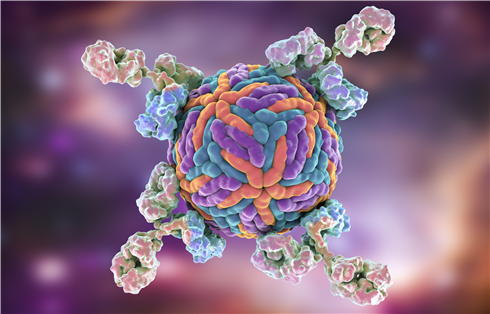B lymphocytes can only produce a proprietary antibody against an antigen determinant, so it has the characteristics of highly specific physical and chemical properties, single biological activity, strong binding specificity with antigen and so on. Monoclonal antibodies are antibodies secreted by a single B lymphocyte clone. After more than 30 years of research and development, monoclonal antibody drugs have made great progress in the treatment of tumors and autoimmune diseases, but also become the fastest growing and most promising development direction in the field of medicine.
Genetic engineering antibody technology mainly includes humanization technology, antibody library technology and transgenic mouse technology. With the promotion of these technologies, the humanization of monoclonal antibodies has been improved, and has been expanded in the direction of miniaturization and functionalization. According to the structure, monoclonal antibodies can be divided into monoclonal antibodies (mouse monoclonal antibody, chimeric monoclonal antibody, humanized monoclonal antibody, fully human monoclonal antibody) and new monoclonal antibodies such as antibody-drug conjugates, multi-specific antibodies, antibody fusion proteins, small molecular antibodies (Fab, ScFv, VHHS) and so on. Among them, the number of humanized monoclonal antibody drugs was the largest, accounting for 37.6% of the total number of monoclonal antibody drugs on the market. The number of small molecule antibodies of new monoclonal antibodies was the largest, accounting for 8.8% of the total number of monoclonal antibody drugs on the market.
At present, the biological functions of monoclonal antibody drugs are mainly reflected in three aspects: key molecules that inhibit tumor survival, immune intrinsic and adaptive activation of tumors, antibody-conjugated cytotoxic drugs. The targets of monoclonal antibody drugs are mainly concentrated in HERTNF, CD20, PD-1/L1, VEGF and CD3. Among them, the number of monoclonal antibody drugs targeting HER2 is the largest, and the mechanism is to down-regulate the expression of HER2 and inhibit tumor growth. The number of monoclonal antibody drugs targeting TNF-α was the second, and its mechanism was to neutralize the activity of free TNF-α and transmembrane TNF-α on the surface of immune cells and block the binding of TNF-α to receptor subunits.
There are more than 20 of the globally listed monoclonal antibody drugs with sales above $1 billion, the top ten of which are:
- Adalimumab (Humira), a TNF-α fully human monoclonal antibody, developed by BASF Knoll and Cambridge Antibody Technology (CAT);
- Infliximab (Remicade), a chimeric monoclonal antibody on human/mouse IgG1k isotype chain, developed by Johnson & Johnson, Merck and Mitsubishi Tanabe Pharma, mainly used in the treatment of Crohn’s disease, ulcerative colitis, rheumatoid arthritis, ankylosing spondylitis, psoriasis arthritis, plaque psoriasis and so on;
- Rituximab (Rituxan, MabThera), a chimeric human/mouse monoclonal antibody against CD20 produced by Roche;
- Trastuzumab (Herceptin), developed by Genentech Company;
- Bevacizumab (Avastin), the world’s first anti-angiogenic drug that can be widely used in a variety of tumors, developed by Genentech, a subsidiary of Roche;
- Nivoluma (Opdivo), a fully humanized IgG4 monoclonal antibody against PD-1, developed jointly by Bristol-Myers Squibb (BMS) and Ono Pharmaceutical;
- Ustekinumab (Stelara), a high affinity, fully humanized IgG1k monoclonal antibody, which targets the p40 subunit of IL-12/IL-23, developed by Johnson & Johnson;
- Denosumab (Pralia), the first human monoclonal antibody targeting the ligand of receptor activator of nuclear factor κB (RANK), developed by Amgen;
- Pembrolizumab (Keytruda), a humanized monoclonal antibody binding to PD-1 receptor, developed by Merck;
- Ranibizumab (Lucentis), the second generation of humanized anti-vascular endothelial growth factor (VEGF) monoclonal antibody fragments, as well as a partial antibody fragment derived from Bevacizumab, developed by Roche’s subsidiary Genentech and Novartis.
Since the first therapeutic monoclonal antibody drug was approved by FDA in 1986, monoclonal antibody drugs have become more and more mature from target development to technological improvement, from clinical research to commercial strategy, and have become the mainstream rookies in the field of medicine. At present, there are hundreds of countries competing for the monoclonal antibody drug market, of which the top 10 countries for drug development and commercialization are the United States, China, Switzerland, Japan, South Korea, the United Kingdom, Germany, Canada, India and France. As of October 2018, United States-based enterprises were far ahead in the development and commercialization of monoclonal antibody drugs, with 761 monoclonal antibody drugs in the clinical stage and 64 drugs on the market.
The global monoclonal antibody drug market, which is about US $100 billion, has maintained a growth rate of more than 10% over the past decade, higher than the average growth rate of 5% to 6% in the pharmaceutical industry. The United States is currently the largest monoclonal antibody drug research and development base in the world. The drugs of PD-1/L1 and Fc fusion protein have broad market prospects. Multi-specific antibodies and antibody-drug conjugates are gradually entering a new stage of development.
The future research and development trend of monoclonal antibodies will focus on new targets, new indications and new drug regimen. First of all, the discovery of PD-1/PD-L1 has led to the rapid growth of tumor monoclonal antibody drugs market. With the development of human post-genomics and metabolomics, increasingly new drug targets will be discovered and studied, and the types of monoclonal antibody drugs will continue to increase. Secondly, a single indication targets a limited patient population. With the deepening of basic research and the breakthrough of clinical trials, monoclonal antibody drugs will infiltrate more and more areas other than malignant tumors and autoimmune diseases. The competitiveness and market space of drugs will be further expanded. Thirdly, the combined use of some drugs is significantly more effective than a single drug clinically. By developing a new drug regimen, the frequency and scope of drug use can be significantly improved.

